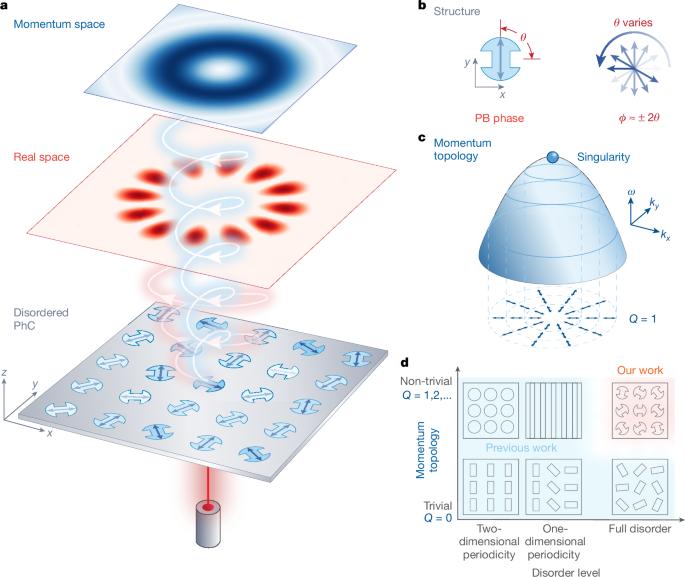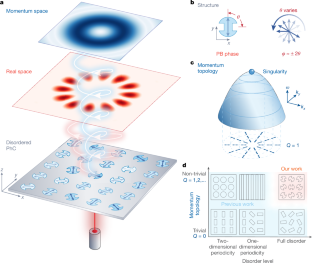Disorder-assisted real–momentum topological photonic crystal
IF 48.5
1区 综合性期刊
Q1 MULTIDISCIPLINARY SCIENCES
引用次数: 0
Abstract
Topological defects and disorder counteract each other1–5. Intuitively, disorder is considered detrimental, requiring efforts to mitigate its effects in conventional topological photonics6–9. We propose a counter-intuitive approach that exploits a real–momentum topological photonic crystal that harnesses real-space disorder to generate a Pancharatnam–Berry phase10,11, without disrupting the momentum-space singularity originating from bound states in the continuum12. This methodology allows flat optical devices to encode spatial information or even extra topological charge in real space while preserving the topology of bound states in the continuum in momentum space with inherent alignment. Here, as a proof of concept, we demonstrate the simultaneous and independent generation of a real-space broadband vortex or a holographic image alongside resonant momentum-space vortex beams with a narrow bandwidth, which cannot be achieved with conventional methods. Such engineered disorder contributes to vast intrinsic freedoms without adding extra dimensions or compromising the optical flatness13,14. Our findings of real–momentum duality not only lay the foundation for disorder engineering in topological photonics but also open new avenues for optical wavefront shaping, encryption and communications. A real–momentum topological photonic crystal that harnesses real-space disorder is used to generate a Pancharatnam–Berry phase while preserving momentum-space topology.


无序辅助实动量拓扑光子晶体
拓扑缺陷和无序相互抵消1,2,3,4,5。直观上,无序被认为是有害的,需要努力减轻其在传统拓扑光子学中的影响6,7,8,9。我们提出了一种反直觉的方法,利用实动量拓扑光子晶体利用实空间无序产生Pancharatnam-Berry相10,11,而不破坏源自连续体中束缚态的动量空间奇点12。这种方法允许平面光学器件在实际空间中编码空间信息甚至额外的拓扑电荷,同时在动量空间中保持具有固有对齐的连续统中的束缚态拓扑。在这里,作为概念证明,我们展示了与窄带宽的共振动量-空间涡旋光束同时独立产生实空间宽带涡旋或全息图像,这是传统方法无法实现的。这样的工程无序有助于在不增加额外维度或损害光学平坦性的情况下获得巨大的内在自由13,14。我们的实动量对偶的发现不仅为拓扑光子学的无序工程奠定了基础,而且为光波前整形、加密和通信开辟了新的途径。
本文章由计算机程序翻译,如有差异,请以英文原文为准。
求助全文
约1分钟内获得全文
求助全文
来源期刊

Nature
综合性期刊-综合性期刊
CiteScore
90.00
自引率
1.20%
发文量
3652
审稿时长
3 months
期刊介绍:
Nature is a prestigious international journal that publishes peer-reviewed research in various scientific and technological fields. The selection of articles is based on criteria such as originality, importance, interdisciplinary relevance, timeliness, accessibility, elegance, and surprising conclusions. In addition to showcasing significant scientific advances, Nature delivers rapid, authoritative, insightful news, and interpretation of current and upcoming trends impacting science, scientists, and the broader public. The journal serves a dual purpose: firstly, to promptly share noteworthy scientific advances and foster discussions among scientists, and secondly, to ensure the swift dissemination of scientific results globally, emphasizing their significance for knowledge, culture, and daily life.
 求助内容:
求助内容: 应助结果提醒方式:
应助结果提醒方式:


